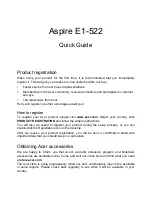
Power
Software Guide
1–3
Understanding Standby and Hibernation
Standby and Hibernation are energy-saving features that conserve
power and reduce startup time. They can be initiated by you or by
the system.
Standby
Standby reduces power to system components that are not in use.
When Standby is initiated, your work is saved in random access
memory (RAM) and the screen is cleared. When you resume
from Standby, your work returns to the screen where you left off.
Hibernation
Hibernation saves your work in RAM to a hibernation file on the
hard drive, then shuts down the tablet PC. When you resume from
Hibernation, your work returns to the screen where you left off.
Compaq recommends that you save your work before initiating
Hibernation whenever:
■
You plan to dock, undock, or connect an external device to
the tablet PC while it is in Hibernation.
■
You may need to resume from Hibernation from a nearly
discharged battery pack.
If a power-on password is set, the password must be entered to
resume from Hibernation.
Hibernation is enabled by default, but can be disabled (usually,
to save space on the hard drive). Disabling Hibernation is not
recommended. When Hibernation is disabled, system-initiated
Hibernation cannot save your work if the tablet PC reaches a
critical low-battery condition while it is on or in Standby.
To verify that Hibernation is enabled, select Start > Control
Panel > Performance and Maintenance icon > Power Options
icon > Hibernate tab. If Hibernation is enabled, the Enable
Hibernation check box is selected.
280125-001.book
Page
3
Sunday,
August
25,
2002
3:51
PM










































